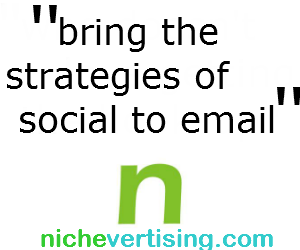 With social media becoming the trendy way for entrepreneurs to communicate with prospective and existing customers, email has become somewhat of the stepchild of business communication. Simply stated, email has lost its sexiness with the rise of social media. As a matter of fact, reports show as much as a 60% decline in email usage among teens. However, I would argue that this is a good thing.
With social media becoming the trendy way for entrepreneurs to communicate with prospective and existing customers, email has become somewhat of the stepchild of business communication. Simply stated, email has lost its sexiness with the rise of social media. As a matter of fact, reports show as much as a 60% decline in email usage among teens. However, I would argue that this is a good thing.
With more and more personal communications moving from the inbox and into the social stream, most people’s email inboxes are being decluttered to focus only on business communications. Most teens aren’t doing a whole lot of business transactions these days, so this explains the drop in their usage.
What this means for all of us entrepreneurs is that if you have neglected your email strategies over the last few years to spend more time on Facebook and Twitter, I am here to tell you that it’s time for you to refocus on what is still the best way to build an ongoing business relationships with your contacts. Instead of changing your communication strategy to abandon email for social, you should instead bring the strategies of social to email.
Social media has taught businesses that they must focus on creating a conversation instead of using traditional one-way communications that dominated the advertising industry up until recent times. In addition, when done appropriately, conversational messages on social sites tend to generate many more comments. Furthermore, based on my observations of my social stream, conversational business messages coupled with an interesting story get shared at more than double the rate as any other type of business message. Based on these observations, in a previous post on the 5 critical skills you must learn to create a viral referral loop, I listed storytelling as #1.
As a result of this, my recommendation for bootstrapping entrepreneurs is simple. It is a must that you bring conversational storytelling into your email communications to give your contacts a reason to share your story with their friends. Below are the three quick tips to get started with this technique:
- Make it personal
The first thing you should do is integrate yourself and your personal experiences into your business communications. If you overcame a problem that you now solve with your business then use that story. You can also get permission from your customers to share their story. Even without using real names, personal stories describing how you and your customers overcame adversities related to your business are powerful. - Ask questions
The easiest way to start a conversation is to ask open ended questions. So instead of doing a survey with a structured format, try this instead. This will allow you to exchange 2 or 3 follow-up emails with several of your customers and build significant rapport with each of them. What’s more, you can leverage your blog or social media pages by encouraging the conversation to continue with a link to one of those platforms. - Use KISS
Keep It Short and Simple. The email inbox is still noisy and therefore requires a strategy to get through it all. Take me for example, I normally scan emails all day long on my phone while I multitask 3 other things at the same time. This allows me to delete as many emails as possible, so at a later time I can focus on the stuff that matters. So just because you are telling a story does not give you the license to write long winded emails. My recommendation is to write a roughly 250 word cliffhanger and then leave a link to your blog or website with an interesting or surprising conclusion.

There is 1 comment. Add yours.